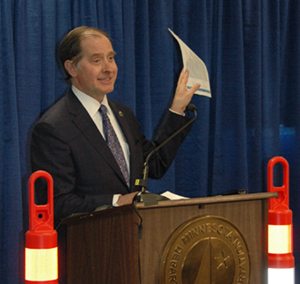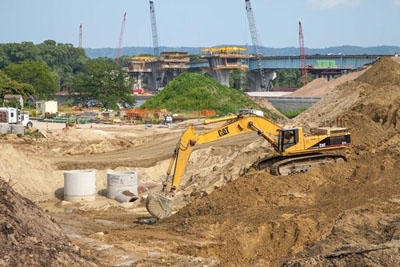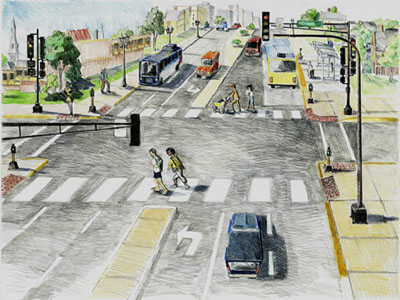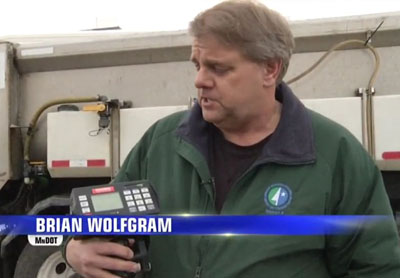 |
|

|
 |
TABLE of CONTENTS
 |
Bulk of 2015 construction program aimed at preserving, maintaining infrastructure |
By Chris Joyce

Commissioner Charlie Zelle announced a $1 billion program of 290 construction projects at a news conference April 2. Photo by Kent Barnard |
Calling transportation “the backbone of our economy and our quality of life,” Commissioner Charlie Zelle on April 2 announced a list of 290 construction projects that will be worked on this year. MnDOT engineers statewide also held local news conferences to provide the district angle on the 2015 construction program.
The projects scheduled for this year will help preserve and maintain state highways, bridges and other transportation infrastructure, Zelle said.
“The bulk of it is replacing the worn parts of the system, the parts that are deteriorating,” he said, adding that there also will be some continuing expansion work.
“We are doing this strong construction program to keep our roadways and bridges and our systems safe, and to maintain a reliable system throughout the state.”
Zelle likened this year’s $1 billion program to “building a Vikings stadium every year.”

Building a new Interstate 90 bridge over the Mississippi River at Dresbach will continue this construction season. Photo courtesy of District 6 |
“The problem is that next year, and the years after, we will see a downturn in the amount of projects, not because there is a lack of need, but because there is a lack of sustainable funding.”
The 2015 construction program includes work on 66 projects in the Twin Cities and 165 projects in Greater Minnesota. An additional 59 projects statewide will improve safety at railroad crossings, repair seawalls and docks, make improvements on runways and terminals at regional airports, and improve transit centers.
High-impact projects include:
- Hwy 610 in northwest Twin Cities metro area – Constructing four-lane road from County Road 81 to Interstate 94
- I-494 – Resurfacing road and repairing or replacing bridges from I-94 to I-694
- Hwy 100 in St. Louis Park – Replacing bridges, adding auxiliary lane and reconstructing road and interchange
- Dresbach Bridge – Replacing I-90 bridge over the Mississippi River
- Hwy 14 – Constructing four-lane road from North Mankato to Nicollet
- I-94 from Rogers to St. Michael – Constructing an additional lane from Hwy 101 to Hwy 241
- Hwy 34 from Detroit Lakes to Akeley – Constructing passing lanes and improving intersections
- Hwy 23 in Duluth – Reconstructing road and constructing new bridge at Kingsbury Creek
- Hwy 12 – Reconstructing and resurfacing road from Atwater to Litchfield
For a complete list of projects, visit www.mndot.gov/construction.

MnDOT, the city of St. Paul and Metro Transit are working together to make one of the busiest areas of the Hamline-Midway neighborhood friendlier for motorists, transit users and pedestrians. This residential and commercial area between Selby Avenue and Pierce Butler Road will soon have wider, more accessible sidewalks and new lighting. Artist rendering courtesy of Metro District |
Sue Mulvihill, deputy commissioner and chief engineer, described what goes into the project selection process, including analyzing the condition of the infrastructure, safety issues, traffic on the roadway, when the last repair or rebuild occurred, and the return on investment.
She noted that MnDOT doesn’t do programming in a vacuum, but works closely with cities, counties, area transportation planners and others to develop the transportation plans.
Mulvihill also talked about the statewide Toward Zero Deaths initiative and the ways MnDOT uses engineering to make highways safe, including installing cable median barriers and rumble strips.
“One thing we can’t do is engineer the behavior of people behind the wheel,” she said, encouraging drivers to pay attention to the speed limits and to put down their cell phones.
To watch the Central Office news conference, click here: https://www.youtube.com/watch?v=IWbcPlt3dr8
Keep up with this year’s construction program throughout the season by reading MnDOT Newsline (www.newsline.dot.state.mn.us/) and by regularly checking MnDOT’s website (www.mndot.gov/roadwork/current.html).
|
 |
|

|
 |
TABLE of CONTENTS
 |
Road surface monitors could help reduce salt usage |
By Shannon Fiecke

Brian Wolfgram, District 6 transportation operations supervisor, speaks with KAAL-TV about his crew’s testing of a mobile road surface sensor that could reduce the amount of salt applied to Minnesota roadways. Screenshot of KAAL-TV broadcast
|
While maintenance crews were busy this past winter keeping roads clear of snow, many also were testing different mobile road condition sensors that could help determine how slippery a road is – and better determine when it's time to apply deicing chemicals.
One such device District 1 is testing uses infrared technology to detect hazardous ice, snow or wet conditions without even touching the pavement. The mobile sensor reports air temperature, surface temperature and road friction data.
"The biggest reason we're looking at this is for the friction reading," said Joe Huneke, salt solutions coordinator. "Typically, when operators are patrolling their route and the road looks like it’s getting icy, they'll err on the side of caution and apply salt — and it may not need it."
The device being used by snow and ice crews in northern Minnesota would also provide real-time surface weather conditions. Currently, plow operators and supervisors must enter road conditions into a computer or relay them by phone, a time-consuming process that operators are not always able to perform in a timely manner. The biggest potential benefit, however, is lower salt consumption.
"Sometimes you get a light cold snow event where it might look like there's a little ice on the road, but, in fact, you have good friction numbers and you don't need salt. Once you put chemical down, you're committed to it," Huneke said.
The device being used in District 1 will be compared with a device tested in District 3, that also uses infrared technology to determine how slippery the road is, and with a technology being tested in District 6 that uses gravitational force to determine the road surface friction.
Related Research
MnDOT’s Office of Maintenance has its own research program designed to let maintenance staff test innovative ideas to keep roads smooth, snow-free and safe. They put out a monthly bulletin featuring new ideas and technologies. (Find the back issues here.) Other winter maintenance research projects are featured in MnDOT’s 2011-2013 Maintenance Operations Research Report. |
 |
|

|
 |
TABLE of CONTENTS
 |
Minnesota’s 2015 waterways shipping season begins |
|
By Marcia Lochner, Office of Freight & Commercial Vehicle Operations

The laker John G. Munson is docked in its winter berth in Superior. It was the first ship to depart the Port of Duluth, marking the beginning of the 2015 shipping season. File photo by Dick Lambert
|
The opening of the Great Lakes and Mississippi River shipping seasons is a welcome sign of spring in Minnesota.
The John G. Munson was the first laker to depart the Port of Duluth-Superior crossing under the Aerial Lift Bridge on March 23, marking the start of the 2015 commercial shipping season at this end of the Great Lakes St.-Lawrence Seaway system. The Munson spent the winter docked in the Fraser Shipyards in Superior and left the Port of Duluth-Superior carrying 24,000 short tons of iron ore pellets.
“We anticipate a banner year here at the Port Terminal for project cargo moving through Duluth in 2015,” said Vanta Coda, Duluth Seaway Port Authority executive director. “This port sits at the nexus of multiple energy sectors, so we’ll be seeing multiple shipments of equipment heading in from Europe and elsewhere destined for wind energy installations and oil/gas fields further north and west. All told, the Port of Duluth-Superior should see a 2 percent increase in activity during 2015.”
The unofficial start of the Upper Mississippi River navigation season began when the motor vessel New Dawn pushed nine barges loaded with dry fertilizer through Lock and Dam 2, near Hastings, Minn., on March 25.
The U.S. Army Corps of Engineers marks the start of the navigation season when the first tow arrives at Lock and Dam 2 because it means all of the locks are accessible to commercial and recreational vessels. The average opening date is March 24. Although much of the Mississippi River tends to be free of ice earlier than that, the thicker ice of Lake Pepin downriver takes longer to thaw. The ice delays the season opening as tows typically wait to break through Lake Pepin’s ice when it is less than 12 inches thick.
“Last year (2014) was a difficult year for river shipping,” said Patrick Phenow, Ports and Waterways program coordinator. He noted the late start (April 16), the early end (Nov. 20), and nearly four weeks of closures due to high water in the spring and silt deposits in the summer that required emergency dredging.
“In spite of all that, it was still the best year on the river system since 2010 in terms of the volume of commodities moved, with a 15 percent increase over 2013,” he said.
During the 2014 Mississippi River shipping season, the combined totals of Minnesota’s inbound and outbound freight tonnage reached 10.7 million tons. Minnesota’s largest river tonnage commodities are corn, soybeans, wheat, fertilizer, aggregate, road salt and cement.
Minnesota’s river and lake ports, commercially navigable waterways and related infrastructure provide high-capacity, low-cost and energy efficient movement of numerous commodities in bulk. To learn more, visit MnDOT’s Ports and Waterways website. |
 |
|

|
 |
TABLE of CONTENTS
 |
Worthington Truck Station's Darryl Jansma dies |
|
By Rebecca Arndt, District 7 public affairs coordinator

Darryl Jansma, assistant supervisor at the Worthington Truck Station, died unexpectedly March 19. Photo courtesy of District 7 |
Darryl Jansma liked keeping busy. He liked the sense of accomplishment when he could see or participate in good work. And he liked plowing snow.
It was that kind of attitude that likely earned Jansma his recent promotion to assistant supervisor at the Worthington Truck Station only one month ago.
And then, on March 19, Jansma died unexpectedly.
“He had a calming effect on people,” said Randy Potts, District 7/Worthington Subarea supervisor. “And, although he said he would never get into management again, he was a natural born leader.”
Jansma was a quick learner, which helped him progress rapidly in his time with District 7. Hired as an emergency appointment in December 2010, he came on full-time as a transportation generalist in April 2011, before moving up to a transportation generalist senior in August 2014.
His co-workers appreciated his impressive one-line jokes and his easy-going nature. Jansma also had strong technical skills and would help others out when they needed it.
His impact was felt by the public he served, too. A recent thank-you note mailed to Jansma at work portrays the kind of man he was:
On the morning of February 12, my daughter was stranded on I-90 just east of Worthington, on her way to take a placement exam at the college. I believe you are the one that stayed with her until AAA arrived and got her going again. Not only did you make sure she was safe and warm on that bitterly cold morning, but you also calmed her down and escorted her to the school so she could take her test.
I am just so grateful for your kindness. When there is so much negativity in the world, it’s uplifting to encounter people like you. Thank you!! -- Lynnette Fay and daughter, Glenna
Funeral services were held March 23 in Worthington. Jansma, 49, is survived by his wife of 25 years, Colleen, children Bradley and Ashley, his parents, five siblings, and many relatives, friends and co-workers. |
 |
|

|
 |
TABLE of CONTENTS
 |
On the Job: Surveying work offers ‘never a dull moment’ for Pete Jenkins |
By Rich Kemp

(from left) Pete Jenkins, Photogrammetric Unit supervisor, and Lloyd Davis, Photogrammetric Unit, look over a mapping product March 9 at the Central Office. Photo by Rich Kemp
|
Pete Jenkins, Office of Land Management, has been involved in the surveying field and land management for more than 30 years. He started with MnDOT in 1998 as a surveyor in District 7. In 2001, he was promoted to the land management engineer for District 7, where he supervised the Surveys and Right of Way offices.
Jenkins moved to the Office of Land Management at Central Office in 2004 as the photogrammetric unit supervisor.
He was recognized as the Surveyor of the Year by the Minnesota Society of Professional Surveyors in February for his work with the Minnesota Land Surveyors Foundation.
How would you describe a surveyor's job?
Most people’s perception of a surveyor is the person outside, standing behind an instrument or performing some measuring function. That is a big part of the job. However, surveyors are involved in all aspects of land development, whether it is in the private sector in building homes and commercial buildings, or in the government sector, building infrastructure for public use. Anytime there is a land component to development, a surveyor is involved in the process because it often involves boundaries.
A land surveyor determines property boundaries and this is the reason for being licensed. Surveyors have to know the exact location of certain features, where the right of way boundary is located, including individual property boundaries. They are involved in the pre-design, design, acquiring of land, and construction phases of MnDOT projects.
How did your job change when you moved to the Office of Land Management at the Central Office?
The biggest difference is, in a district, I worked with the projects in that area of the state, and at CO, I work to help each of those districts. Anything we can do that gives them a quality project or provides quality advice, or helps them do their job better is the reason we exist here at the Central Office.
How would you compare your job from when you started in District 7 to where you are today?
When I started as a surveyor, I worked on the ground with projects that were for the public, used by your friends and neighbors. You are closely tied to the project. I do miss that closeness to projects. The nice thing about being at CO is you are seeing all the projects. You have a much bigger perspective.
The photogrammetric unit works with the district surveyors to plan aerial projects based on the parameters of the district’s needs. We hire a contractor to fly and capture imagery within specific requirements. We inspect the quality of the imagery for mapping suitability and then, at the request of the district, we either hire a consultant to map it or do the work with our own staff. Because this is the basis for all of our volumetric calculations and tied to the construction contracts, we follow national standards for this work.
How did you earn the surveying award?
I am a member of the Minnesota Society for Professional Surveyors and serve as a director for the Minnesota Land Surveyors Foundation. As part of my work with the foundation, I do fundraising to provide scholarships for surveying students. I created an endowment for St. Cloud State University. The Upper Midwest Surveying Education Fund supports purchasing software and surveying equipment at SCSU. In addition, the program provides opportunities for students to attend survey events and competitions.
For my work in creating the endowment, MSPS honored me with the Surveyor of the Year award.
Have there been any changes in the surveying field?
Technology has changed a lot in this business. Due to those changes, the number of people in a surveying crew reduced in size from three or four down to one or two. Technology is a blessing and a curse. The capabilities of the latest tools make for an attractive work environment, but time savings and efficiencies mean you can do more with less. The newest example is the use of unmanned aircraft systems for aerial scanning.
What has been the best part of your career at MnDOT?
Surveying, whether in the field or in the office, is an exciting area to work in. There is never a dull moment. The technology is always advancing.
Most importantly, I was blessed to have wonderful bosses. Even in the private sector, my first mentor was a former MnDOT surveyor. They were all very supportive of my personal and professional goals.
Do you or a co-worker have an interesting job to share with readers? Click here to send us your ideas, and we’ll contact you for more information.
Recent employee profiles:
|
 |
|
| |
|



